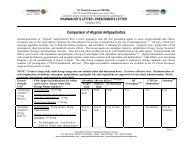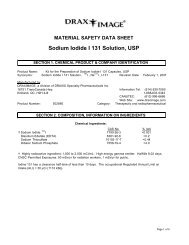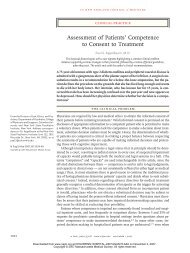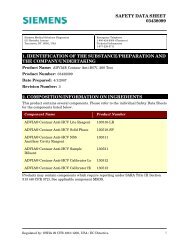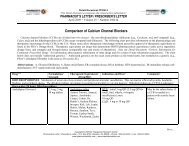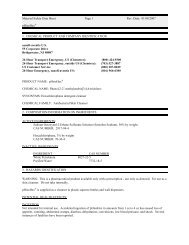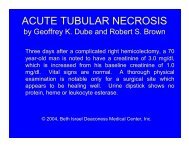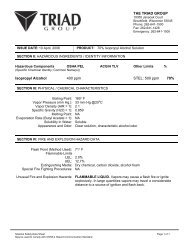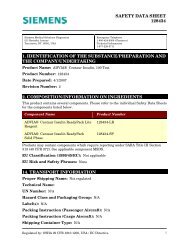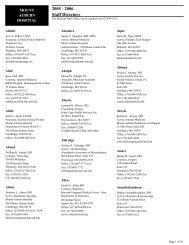Troponin - Non-MI Causes of Troponin Elevation
Troponin - Non-MI Causes of Troponin Elevation
Troponin - Non-MI Causes of Troponin Elevation
Create successful ePaper yourself
Turn your PDF publications into a flip-book with our unique Google optimized e-Paper software.
Common <strong>Causes</strong> <strong>of</strong> <strong>Troponin</strong> <strong>Elevation</strong>sin the Absence <strong>of</strong> Acute MyocardialInfarction*Incidence and Clinical SignificanceChanwit Roongsritong, MD; Irfan Warraich, MD; and Charles Bradley, PhDCardiac troponin is a preferred biomarker <strong>of</strong> acute myocardial infarction (<strong>MI</strong>). Unfortunately,elevation <strong>of</strong> troponin can be detected in a variety <strong>of</strong> conditions other than acute <strong>MI</strong>. This reviewfocuses on the incidence and clinical significance <strong>of</strong> increased troponin in conditions commonlyassociated with troponin elevations, particularly in those that may resemble acute <strong>MI</strong>.(CHEST 2004; 125:1877–1884)Key words: false-positive; heart failure; pericarditis; pulmonary embolism; sepsis; troponinAbbreviations: CAD coronary artery disease; CK creatinine kinase; HF heart failure; <strong>MI</strong> myocardial infarction;PE pulmonary embolism; TnI troponin I; TnT troponin T*From the Cardiovascular Division, Department <strong>of</strong> InternalMedicine (Dr. Roongsritong), and Department <strong>of</strong> Pathology(Drs. Warraich and Bradley), Texas Tech University HealthSciences Center, Lubbock, TX.Manuscript received April 8, 2003; revision accepted August 6,2003.Reproduction <strong>of</strong> this article is prohibited without written permissionfrom the American College <strong>of</strong> Chest Physicians (e-mail:permissions@chestnet.org).Correspondence to: Chanwit Roongsritong, MD, Department <strong>of</strong>Internal Medicine, Texas Tech University Health Sciences Center,3601 Fourth St, Lubbock, TX 79430Cardiac troponins are the most sensitive andspecific biochemical markers <strong>of</strong> myocardialdamage. 1 In patients with clear-cut unstable angina,cardiac troponin measurements provide superiorprognostic information over creatinine kinase (CK). 2The current guidelines 3 from the Joint EuropeanSociety <strong>of</strong> Cardiology/American College <strong>of</strong> CardiologyCommittee for the redefinition <strong>of</strong> myocardialinfarction (<strong>MI</strong>) state that cardiac troponins are thepreferred markers for detecting myocardial cell injury.Therefore, one <strong>of</strong> the cardiac troponins isroutinely measured in patients presenting with acutechest pain syndrome, acute dyspnea, or other complaintsin which acute <strong>MI</strong> is one <strong>of</strong> the differentialdiagnoses. However, troponin elevations indicate thepresence but not the mechanism <strong>of</strong> myocardialinjury, and myocardial damage can occur from avariety <strong>of</strong> mechanisms other than acute ischemia.Although a thorough clinical evaluation and the timecourse <strong>of</strong> troponin elevation will <strong>of</strong>ten help discriminateacute <strong>MI</strong> from other causes, knowledge aboutthe potential elevations <strong>of</strong> troponin in these conditionsmay minimize unnecessary discomfort and costassociated with cardiac testing to exclude coronaryartery disease (CAD).Furthermore, all <strong>of</strong> the currently available troponinmeasurements utilize two-site immunoassays.Similar to other immunoassays, spurious elevations<strong>of</strong> cardiac troponin from interference in the absence<strong>of</strong> <strong>MI</strong>, known as false-positive troponin, have beenreported. 4–5 This review will focus on the incidence,magnitude, and clinical significance <strong>of</strong> troponin elevationsin conditions other than acute <strong>MI</strong>, particularlyin those conditions that may resemble acutecoronary syndrome (Table 1), and the commoncauses <strong>of</strong> false-positive troponin.Acute PericarditisPatients with acute pericarditis usually presentwith chest pain and ST-segment changes on ECG.Modest elevation <strong>of</strong> the MB fraction <strong>of</strong> CK (CK-MB) has been found in patients with acute pericarditis.6 <strong>Troponin</strong> elevation has also been reported inpatients with acute pericarditis. 7–8 However, theavailable data on the prevalence and extent <strong>of</strong> troponinelevation in this condition are limited.Bonnefoy et al 8 reported that approximately onehalf <strong>of</strong> their 69 consecutive patients (49%) with acuteidiopathic pericarditis had troponin I (TnI) levels 0.5 ng/mL. Twenty-two percent had TnI levels 1.5 ng/mL, their cut-<strong>of</strong>f level for acute <strong>MI</strong>. Theaverage TnI level was 8 12 ng/mL (range, 0 to 48ng/mL). The median level was, however, only 1www.chestjournal.org CHEST / 125 /5/MAY, 2004 1877
Table 1—Conditions Commonly Associated WithCardiac <strong>Troponin</strong> <strong>Elevation</strong>s in the Absence <strong>of</strong>Acute <strong>MI</strong>Acute PEAcute pericarditisAcute or severe HFMyocarditisSepsis and/or shockRenal failureFalse-positive troponinng/mL. ST-segment elevation was found in almostevery patient (93%) with TnI levels 1.5 ng/mL,compared to 65% in the entire group. A troponinlevel above the cut-<strong>of</strong>f for acute <strong>MI</strong> was morecommon in younger patients (37 years vs 52 years,p 0.002) and in those with a history <strong>of</strong> recentinfection (66% vs 31%, p 0.01). <strong>Elevation</strong> <strong>of</strong> troponinin acute pericarditis is believed to representinjury <strong>of</strong> the epicardial layer <strong>of</strong> myocardium adjacentto visceral pericardium where the active inflammationoccurs.Acute Pulmonary EmbolismPatients with acute pulmonary embolism (PE)<strong>of</strong>ten present with acute dyspnea and/or chest pain.Echocardiographic evidence <strong>of</strong> right ventricular dysfunctionwas reported in 40 to 55% <strong>of</strong> patients withacute PE. 9–10 Right ventricular dysfunction in acutePE has been associated with increased mortality. 9–10<strong>Elevation</strong> <strong>of</strong> CK-MB has been reported in acutemassive PE. 11–12 Since cardiac troponins are moresensitive than CK-MB in detecting myocardial injury,measurement <strong>of</strong> cardiac troponin may providesuperior information for the management <strong>of</strong> patientswith PE.Giannitis et al 13 reported the incidence and prognosticsignificance <strong>of</strong> troponin T (TnT) elevation inpatients with confirmed acute PE. Of the 56 patients,32% had elevated TnT levels ( 0.1 ng/mL).In contrast, only 7% had CK levels above twice theupper limit <strong>of</strong> normal. Using a clinical gradingsystem adapted from Goldhaber, 14 23%, 46%, and30% <strong>of</strong> the patients were classified as having smallPE, moderate-to-large PE, and massive PE, respectively.Elevated TnT was only observed in patientswith either moderate-to-large PE or massive PE.<strong>Non</strong>e <strong>of</strong> those with small PE had increased TnT.TnT-positive patients were more likely to haveright ventricular dysfunction, severe hypoxemia, prolongedhypotension, or cardiogenic shock. They alsomore <strong>of</strong>ten required inotropic therapy or mechanicalventilation than those with negative TnT. Completeor incomplete right bundle-branch block or ST-Tchanges on ECG were also more prevalent in TnTpositivesubgroup. More importantly, TnT positivitywas associated with approximately 30-fold increasedrisk <strong>of</strong> in-hospital mortality. In addition, TnT levelwas found to be an independent predictor <strong>of</strong> the30-day outcome. Survival rates at 30 days were 60%and 95%, respectively, for those with and withoutTnT elevation (Table 2).Right ventricular dilation and strain from suddenincrease in pulmonary arterial resistance is believedto be the cause <strong>of</strong> troponin release in acute PE. 15Unfortunately, coexisting CAD is not uncommon inpatients with acute PE. In the study by Giannitis etal, 13 a 20% incidence <strong>of</strong> previous <strong>MI</strong> was reported.Twelve percent <strong>of</strong> their patients had previous coronaryrevascularization. Significant CAD, defined as a 50% luminal diameter stenosis, was also morecommon in TnT-positive than TnT-negative patients(40% vs 27%, respectively). Although left ventricularinfarction may not be completely excluded in patientswith concomitant CAD, troponin elevationswere observed even in those without CAD. Moreover,a recent study 15 in patients with submassivePE, defined as all confirmed PE except massive PEassociated with hypotension, cardiogenic shock, orrespiratory failure, has strongly suggested that myocardialischemia from CAD is not the major cause <strong>of</strong>troponin elevation in acute PE. In this study byDouketis et al, 15 patients with a history <strong>of</strong> confirmedCAD, congestive heart failure, or cardiomyopathywere excluded. Of 24 patients, 21% had TnI levels 0.4 ng/mL. TnI levels above the cut-<strong>of</strong>f for acute<strong>MI</strong> in their laboratory (2.3 ng/mL) were detected in4% <strong>of</strong> the patients. The lower incidence <strong>of</strong> troponinelevation in the latter study is likely due to theexclusion <strong>of</strong> patients with massive PE.Acute or Severe Heart FailureAcute coronary syndrome occasionally presentswith a sudden increase <strong>of</strong> dyspnea without typicalangina. In elderly, dyspnea is a major complaint in alarge number <strong>of</strong> patients with acute <strong>MI</strong>. 16 In patientswith severe but stable heart failure (HF), a modestincrease <strong>of</strong> cardiac troponin has been reported. 17Using a highly sensitive TnI assay with a lowerdetection limit at 3 pg/mL, Missov et al 17 found asignificantly higher level <strong>of</strong> TnI in patients withstable HF than in control subjects (72 pg/mL vs 25pg/mL, p 0.01). However, a TnI level 0.1 ng/mL, a normal detectable level on standard assay, wasfound in only 1 <strong>of</strong> their 35 patients (0.206 ng/mL). Amuch higher incidence <strong>of</strong> detectable TnI has beenreported in a combined population <strong>of</strong> hospitalized1878 Reviews
Table 2—Incidence and Clinical Significance <strong>of</strong> <strong>Troponin</strong> <strong>Elevation</strong>s in Various Conditions*Conditions<strong>Troponin</strong>SubunitCut-<strong>of</strong>fs,ng/mLIncidence,% Clinical Significance <strong>of</strong> <strong>Troponin</strong> <strong>Elevation</strong>Acute pericarditis TnI 0.5 49 Correlates with recent infection1.5 22Acute PEOverall TnT 0.1 32 Increased risk <strong>of</strong> in-hospital mortality, poor30-d outcome, right ventriculardysfunction, shock/hypotension, andneed for mechanical ventilationMassive 53Small 0Submassive TnI 0.4 212.3 4HFSevere but stable TnI 0.1 3 Independent predictor <strong>of</strong> long-termsurvival or readmission for HF;correlates with worse functional class,and lower ejection fractionTnT 0.1 151.0 3Hospitalized HF TnT 0.1 71.0 2Stable or unstable TnI 0.3 231.0 0Acute left HF TnI 1.0 20TnT 0.1 551.0 7Cor pulmonale TnI 1.0 0Myocarditis TnI 3.1 34 Correlates with recent onset <strong>of</strong> HF andmore diffuse myocarditisSevere sepsis/shock TnI 0.1 58–85 Correlates with APACHE II score anddegree <strong>of</strong> hypotension; increased inhospitalmortality; independent predictor<strong>of</strong> left ventricular dysfunction0.4 50TnT 0.1 36–69Renal failure TnI 0.1 6 Independent predictor <strong>of</strong> poor long-termoutcome0.4 1TnT 0.03 530.1 20*APACHE acute physiology and chronic health evaluation.HF and stable HF patients seen in the outpatientclinic. 18 Using Stratus II (Dade International; Deerfield,IL) TnI assays, La Vecchia et al 18 found TnIlevels above the detection limit (0.3 ng/mL) in 23%<strong>of</strong> their 26 patients. Unfortunately, the proportions<strong>of</strong> patients with stable and unstable HF were notreported. Nevertheless, the degree <strong>of</strong> TnI elevationwas similarly modest, with the highest level <strong>of</strong> only0.8 ng/mL.The incidence <strong>of</strong> elevated TnT in chronic HF hasalso been reported. 19–20 In 33 patients with stableHF, Missov and Mair 19 found that 15% had detectableTnT ( 0.1 ng/mL). However, only 9% and 3%<strong>of</strong> their patients had TnT levels 0.5 ng/mL and 1.0 ng/mL, respectively.Setsuda et al 20 reported TnT levels <strong>of</strong> at least 0.02ng/mL in 52% <strong>of</strong> their 58 patients hospitalized forHF. Of all patients with detectable TnT in the latterstudy, 87% had TnT levels between 0.02 ng/mL and0.1 ng/mL, 10% had TnT levels between 0.1 ng/mLand 1.0 ng/mL, and only 3% had TnT levels 1ng/mL.Published data on troponin elevations in patientswith acute HF, particularly right HF from corpulmonale, are limited. Perna et al 21 recently reporteda 55% incidence <strong>of</strong> TnT <strong>of</strong> 0.1 ng/mL inpatients with acute cardiogenic pulmonary edema.The highest level <strong>of</strong> TnT in these patients was 2.6ng/mL, and 7% <strong>of</strong> the patients had TnT levels 1ng/mL. Guler et al 22 studied 41 patients with acuteleft heart failure and 17 patients with worsening <strong>of</strong>right HF. In 23 <strong>of</strong> 41 patients with left HF, CAD waswww.chestjournal.org CHEST / 125 /5/MAY, 2004 1879
published. 25–28 Ammann et al 25 evaluated patientswith sepsis, 40% <strong>of</strong> whom were in shock. Seventeen<strong>of</strong> their 20 patients (85%) had TnI elevation. TnIlevels ranged from 0.17 to 15.4 ng/mL, with amedian value <strong>of</strong> 0.57 ng/mL. ver Elst et al 26 foundTnI levels <strong>of</strong> at least 0.4 ng/mL in 50% <strong>of</strong> their 46patients with early septic shock. Similarly, a relativelylow median level (1.4 ng/mL) <strong>of</strong> the peak concentrations<strong>of</strong> TnI was observed in this study. In patientswith severe sepsis, septic shock, or hypovolemicshock, Arlati et al 27 found elevated TnI elevation in74% <strong>of</strong> the cases. All <strong>of</strong> their 12 patients withhypovolemic shock and 58% <strong>of</strong> those with severesepsis or septic shock had elevated TnI.<strong>Elevation</strong> <strong>of</strong> TnT in sepsis has also been reported.26,28 ver Elst et al 26 found cardiac TnT elevations( 0.1 ng/mL) in 36% <strong>of</strong> their cases. A muchhigher incidence <strong>of</strong> TnT elevation was reported bySpies et al 28 ; in their 26 patients with sepsis, 69% hadTnT levels 0.2 ng/mL.Furthermore, elevations <strong>of</strong> troponin in these patientsappear to correlate with severity <strong>of</strong> the diseaseprocess. TnI levels were found to correlate with thedegree <strong>of</strong> hypotension 27 and APACHE (acute physiologyand chronic health evaluation) II score. 26The causes <strong>of</strong> troponin elevations in these criticallyill patients are not well understood. Thesereports, in general, had a relatively small sample sizeand included a heterogeneous group <strong>of</strong> patients.Some <strong>of</strong> these patients had CAD, and stress-induced<strong>MI</strong> may have been responsible for troponin releasein this particular subgroup <strong>of</strong> patients. Acute coronaryevents have, however, been excluded in some <strong>of</strong>these patients. For example, Ammann et al 25 wereable to exclude CAD in 10 <strong>of</strong> 17 TnI-positivepatients. These findings indicated that other mechanismsare also involved.In one study, 26 patients with elevated troponinlevels are older and more likely to have hypertensionor previous history <strong>of</strong> <strong>MI</strong>, suggesting that theirunderlying cardiovascular disease may, to some degree,contribute to troponin elevation. However,these findings were not observed in another study. 28It also remains unclear whether infection with anyspecific pathogens is more likely to result in troponinelevations. Streptococcal pneumoniae infection wasthe cause <strong>of</strong> sepsis in 41% <strong>of</strong> TnI-positive patients inone study, 25 whereas Gram-negative bacteria werethe <strong>of</strong>fending pathogens in 63% <strong>of</strong> cases in anotherstudy. 26 Spies et al 28 found no difference in terms <strong>of</strong>the causes <strong>of</strong> sepsis between patients with or withouttroponin elevation.Nevertheless, there are several potential mechanisms,other than acute <strong>MI</strong>, for troponin release inseptic patients. First, it is well known that a number<strong>of</strong> local and circulating mediators (eg, cytokines orreactive oxygen species) possess direct cardiac myocytoxicproperties. 26 Secondly, myocardial injuryfrom the effect <strong>of</strong> bacterial endotoxins has beendemonstrated. Finally, dysfunction <strong>of</strong> the microcirculationhas been described in sepsis. 29 This microvasculardysfunction can lead to ischemia and reperfusioninjury <strong>of</strong> the myocardial cell.More importantly, troponin measurements inthese patients appear to provide valuable prognosticinformation. ver Elst et al 26 reported that both TnIand TnT were independent markers <strong>of</strong> left ventriculardysfunction in patients with sepsis. They detectedleft ventricular dysfunction by transesophagealechocardiography in 78% and 9% <strong>of</strong> patientswith and without TnI elevation, respectively(p 0.001). Several studies 26,28,30 also found a weakcorrelation between elevated cardiac troponin andhospital mortality.Renal FailureThe prevalence and clinical significance <strong>of</strong> elevatedtroponins in patients with renal failure havebeen recently reviewed elsewhere. 31 In brief, TnT ismore commonly elevated in patients with renalfailure than TnI. Although the exact causes <strong>of</strong> troponinelevation in renal failure remain debatable,patients with elevated troponin generally have worseclinical outcome than those without it.False-Positive <strong>Troponin</strong><strong>Troponin</strong> complex is located on the thin filament<strong>of</strong> skeletal and myocardial muscle. An importantfeature <strong>of</strong> troponin complex is that its I and Tsubunits are sufficiently unique so that specificantisera can differentiate these two tissue forms. Thehigh sensitivity and specificity <strong>of</strong> cardiac troponin fordetecting myocardial injury is well documented. 32–33However, various factors can interfere with the TnIassay, leading to falsely elevated levels (Table 3).These include heterophilic antibodies, 34 rheumatoidfactor, 35 fibrin clots, 36 microparticles, 36 and malfunction<strong>of</strong> the analyzer itself. 37The role <strong>of</strong> heterophilic antibodies in causinginterference in immunoassays has been reported in aTable 3—Common <strong>Causes</strong> <strong>of</strong> False-Positive <strong>Troponin</strong>Heterophilic antibodiesRheumatoid factorFibrin clotsMicroparticlesAnalyzer malfunctionwww.chestjournal.org CHEST / 125 /5/MAY, 2004 1881
number <strong>of</strong> studies. 34,38–41 The incidence <strong>of</strong> thisinterference varies considerably in the literature,40–43 ranging from 0.17 to 40%. Various sourceshave been proposed to give rise to heterophilicantibodies, and these include the use <strong>of</strong> mousemonoclonal antibodies in diagnostic imaging andcancer therapy, 44 exposure to microbial antigens, 39,45exposure to foreign animal proteins, 41 and autoimmunediseases such as rheumatoid arthritis. 38,40Recognizing the significance <strong>of</strong> this interferenceby heterophilic antibodies, the manufacturers recommendusing the antibody blocking agents alongwith their cardiac troponin immunoassays wheneverthis interference is suspected. 46–47 However, theresults <strong>of</strong> these blocking agents are not very convincing.34,37,48–53 Therefore, it is important that themanufacturers continue to improve their assays. Inthis regard, Kim et al 43 evaluated the performance <strong>of</strong>the revised Dimension cardiac TnI assay (DadeBehring; Deerfield, IL). They found that the revisedDimension cardiac TnI assay removed the interferencein most <strong>of</strong> the samples with which the originalDimension cardiac TnI assay had given falsely elevatedlevels, and greatly decreased the interferencein the remaining samples.Rheumatoid factor is another cause <strong>of</strong> interferencein the immunoassays. It has been reported that5% <strong>of</strong> healthy patients might have circulating rheumatoidfactor, and approximately 1% <strong>of</strong> patients withelevated cardiac TnI levels may have this elevationsolely because <strong>of</strong> the rheumatoid factor. 54 When thisscenario is suspected, a rheumatoid factor-blockingagent can be used. 38Excess fibrin is another well-reported source <strong>of</strong>falsely elevated cardiac TnI levels. 36 Roberts et al 55observed that incompletely clotted specimencontributed to the false elevations in cardiac TnIlevels with the Stratus II batch analyzer (DadeInternational). The manufacturers mention this possibilityin the package insert and advise care with thespecimens from patients receiving anticoagulanttherapy. The investigators found three approaches tobe useful to correct this interference: (1) heparinizingthe tubes before analysis, (2) removing excessfibrin by repeating the centrifugation, and (3) addingSuperSerum (TTC; Edison, NJ), which containsprotamine sulfate, thrombin, and snake venom toenhance coagulation.In addition, Roberts et al 55 found that some <strong>of</strong> theinterference due to free fibrin and microparticles canbe avoided with repeat centrifugation <strong>of</strong> the sampleand/or the use <strong>of</strong> a clot activator. However, Beyne etal, 56 in an open comparative study, found that asingle centrifugation <strong>of</strong> collection tubes containingthrombin as a clot activator is not enough to avoidfalse-positive cardiac TnI results on the ACCESSanalyzer (Beckman Coulter; Fullerton, CA).Finally, malfunction <strong>of</strong> the analyzer itself is anotherreported cause <strong>of</strong> false elevations in cardiacTnI results. Galambos et al 37 reported several cases<strong>of</strong> falsely elevated plasma cardiac TnI levels due to atemporary malfunction <strong>of</strong> the AxSYM analyzer (AbbottLaboratories; Abbott Park, IL). The operationmanual provided by the manufacturer mentions thepossibility <strong>of</strong> a solution dispenser misalignment ifthe dispensers are repositioned incorrectly duringthe weekly maintenance. 57 The authors recommendrunning quality-control samples after each maintenance<strong>of</strong> the analyzer.ConclusionsCardiac troponin can be elevated in a variety <strong>of</strong>conditions other than acute <strong>MI</strong>. Therefore, an accuratediagnosis in a patient with elevated troponinrelies heavily on the clinical information in thatparticular case. Increased levels <strong>of</strong> troponin in theseconditions generally provide significant prognosticinformation. Knowledge about the incidence, clinicalcorrelation, and clinical significance <strong>of</strong> increasedtroponin in these conditions are important in thecurrent era <strong>of</strong> widespread and indiscriminate testing<strong>of</strong> troponin in clinical practice.References1 A Jaffe AS, Ravkilde J, Roberts R, et al. It’s time for a changeto a troponin standard. Circulation 2000; 102:1216–12202 Antman EM, Tanasijevic MJ, Thompson B, et al. Cardiacspecifictroponin I levels to predict the risk <strong>of</strong> mortality inpatients with acute coronary syndromes. N Engl J Med 1996;335:1342–13493 Myocardial infarction redefined: a consensus document <strong>of</strong> theJoint European Society <strong>of</strong> Cardiology/American College <strong>of</strong>Cardiology Committee for the redefinition <strong>of</strong> myocardialinfarction. J Am Coll Cardiol 2000; 36:959–9694 Fleming SM, O’Byrne L, Finn J, et al. False-positive cardiactroponin I in a routine clinical population. Am J Cardiol 2002;89:1212–12155 Kim WJ, Laterza OF, Hock KG, et al. Performance <strong>of</strong> arevised cardiac troponin method that minimizes interference’sfrom heterophilic antibodies. Clin Chem 2002; 48:1028–10346 Karjalainen J, Heikkila J. Acute pericarditis: myocardial enzymerelease as evidence for myocarditis. Am Heart J 1986;111:546–5527 Brandt RR, Filzmanier K, Hanrath P. Circulating cardiactroponin I in acute pericarditis. Am J Cardiol 2001; 81:1326–13288 Bonnefoy E, Gordon P, Kirkorian G, et al. Serum cardiactroponin I and ST-segment elevation in patients with acutepericarditis. Eur Heart J 2000; 21:832–8369 Goldhaber SZ, Visani L, De Rosa M, for ICOPER. Acutepulmonary embolism: clinical outcomes in the International1882 Reviews
Cooperative Pulmonary Embolism Registry (ICOPER). Lancet1999; 353:1386–138910 Ribeiro A, Lindmarker P, Juhlin-Dannfelt A, et al. EchocardiographyDoppler in pulmonary embolism: right ventriculardysfunction as a predictor <strong>of</strong> mortality. Am Heart J 1997;95:67–6811 Como-Canella I, Gamello C, Martinez-Onsurbe O, et al.Acute right ventricular infarction secondary to a massivepulmonary thromboembolism. Eur Heart J 1988; 9:534–54012 Adams JE III, Seigel BA, Goldstein JA, et al. <strong>Elevation</strong> <strong>of</strong>CK-MB following pulmonary embolism: a manifestation <strong>of</strong>occult right ventricular infarction [letter]. Chest 1994; 105:161713 Giannitis E, Muller-Bardorff M, Volkhard K, et al. Independentprognostic value <strong>of</strong> cardiac troponin T in patients withconfirmed pulmonary embolism. Circulation 2000; 102:211–21714 Goldhaber SZ. Treatment <strong>of</strong> acute pulmonary embolism. In:Braunwald E, Goldhaber SZ, eds. Atlas <strong>of</strong> heart disease.Vol 3. Cardiopulmonary diseases and cardiac tumors. Philadelphia,PA: Current Medicine, 199515 Douketis JD, Crowther MA, Stanton EB, et al. Elevatedcardiac troponin levels in patients with subacute pulmonaryembolism. Arch Intern Med 2002; 162:79–8116 Muller R, Gould L, Betzu R, et al. Painless myocardialinfarction in the elderly. Am Heart J 1990; 119:202–20417 Missov E, Calzolari C, Pau B. Circulating cardiac troponin Iin severe congestive heart failure. Circulation 1997; 96:2953–295818 La Vecchia L, Mezzena G, Ometto R, et al. Detectable serumtroponin I in patients with heart failure nonmyocardial ischemicorigin. Am J Cardiol 1997; 80:88–9019 Missov E, Mair J. A novel biochemical approach to congestiveheart failure: cardiac troponin T. Am Heart J 1999; 138:95–9920 Setsuda K, Seino Y, Takahashi N, et al. Clinical significance <strong>of</strong>elevated levels <strong>of</strong> cardiac troponin T in patients with chronicheart failure. Am J Cardiol 1999; 84:608–61121 Perna ER, Macin SM, Parras JI, et al. Cardiac troponin Tlevels are associated with poor short- and long-term prognosisin patients with acute cardiogenic pulmonary edema. AmHeart J 2002; 143:814–82022 Guler N, Bilge M, Eryonucu B, et al. Cardiac troponin Ilevels in patients with left heart failure and cor pulmonale.Angiology 2001; 52:317–32223 Cummins B, Auckland ML, Cummins P. Cardiac-specifictroponin-I radioimmunoassay in the diagnosis <strong>of</strong> acute myocardialinfarction. Am Heart J 1987; 113:1333–134424 Smith SC, Ladenson JH, Mason JW, et al. <strong>Elevation</strong>s <strong>of</strong>cardiac troponin I associated with myocarditis, experimentaland clinical correlates. Circulation 1997; 95:163–16825 Ammann P, Fehr T, Minder EI, et al. <strong>Elevation</strong> <strong>of</strong> troponinI in sepsis and septic shock. Intensive Care Med 2001;27:965–96926 ver Elst KM, Spapen HD, Nguyen DN, et al. Cardiactroponins I and T are biological markers <strong>of</strong> left ventriculardysfunction in septic shock. Clin Chem 2000; 46:650–65727 Arlati S, Brenna S, Prencipe L, et al. Myocardial necrosis inICU patients with acute non-cardiac disease: a prospectivestudy. Intensive Care Med 2000; 26:31–3728 Spies C, Haude V, Fitzner R, et al. Serum cardiac troponin Tas a prognostic marker in early sepsis. Chest 1998; 113:1055–106329 Hinshaw LB. Sepsis/septic shock: participation <strong>of</strong> the microcirculation;an abbreviated review. Crit Care Med 1996;24:1072–107830 Kollef MH, Ladenson JH, Eisenberg PR. Clinically recognizedcardiac dysfunction: an independent determinant <strong>of</strong>mortality among critically ill patients. Chest 1997; 111:1340–134731 Hamm CW, Giannitsis E, Katus HA. Cardiac troponin elevationsin patients without acute coronary syndrome. Circulation2002; 106:2871–287232 Guest TM, Ramantham AV, Tuteur PG, et al. Myocardialinjury in critically ill patients: a frequently unrecognizedcomplication. JAMA 1995; 273:1945–194933 Bodor GS, Porterfield D, Voss EM, et al. Cardiac troponin Iis not expressed in fetal and healthy or diseased adult humanskeletal muscle tissue. Clin Chem 1995; 41:1710–171534 Fitzmaurice TF, Brown C, Rifai N, et al. False increase <strong>of</strong>cardiac troponin I with heterophilic antibodies. Clin Chem1998; 44:2212–221435 Schifman RB, James SH, Sadrzadeh SMH, et al. Betweenassayvariation in false positive troponin I measurements inpatients on renal dialysis or with positive rheumatoid factor[abstract]. Clin Chem 1999; 45:A14536 Nosanchuk JS. False increases <strong>of</strong> troponin I attributable toincomplete separation <strong>of</strong> serum [letter]. Clin Chem 1999;45:71437 Galambos C, Brink DS, Ritter D, et al. False-positive plasmatroponin I with the AxSYM analyzer. Clin Chem 2000;46:1014–101538 Dasgupta A, Banjiree SK, Datta P. False positive troponin I inthe MEIA due to the presence <strong>of</strong> rheumatoid factors inserum. Am J Clin Pathol 1999; 112:753–75639 Covinsky M, Laterza O, Pfeifer JD, et al. An IgM antibody toEscherichia coli produces false-positive results in multipleimmunometric assays. Clin Chem 2000; 46:1157–116140 Boscato LM, Stuart MC. Incidence and specificity <strong>of</strong> interferencein two-site immunoassays. Clin Chem 1986; 32:1491–149541 Kricka LJ. Human anti-animal antibody interference in immunologicassays. Clin Chem 1999; 45:942–95642 Thompson RJ, Jackson AP, Langlios N. Circulating antibodiesto mouse monoclonal immunoglobulins in normal subjects:incidence, species specificity, and effects on a two-site assayfor creatine kinase-MB isoenzyme. Clin Chem 1986; 32:476–48143 Kim WJ, Lazerta OF, Hock KG, et al. Performance <strong>of</strong> arevised cardiac troponin method that minimizes interferencesfrom heterophilic antibodies. Clin Chem 2002; 48:1028–103444 Carey G, Lisi PJ, Schroeder TJ. The incidence <strong>of</strong> antibodyformation to OKT3 consequent to its use in organ transplantation.Transplantation 1995; 60:151–15845 Posnet DN, Edinger J. When do microbes stimulate rheumatoidfactor? J Exp Med 1997; 185:1721–172346 Vaidya HC, Beatty GB. Eliminating interference from heterophilicantibodies in a two-site immunoassay for creatininekinase MB by using Fab conjugate and polyclonal mouse IgG.Clin Chem 1992; 38:1737–174247 Yeo KT, Storm CA, Li Y, et al. Performance <strong>of</strong> the enhancedAbbott AxSYM cardiac troponin I reagent in patients withheterophilic antibodies. Clin Chim Acta 2000; 292:13–2348 Turpeinen U, Lehtovirta P, Stenman UH. CA125 determinedby three methods in samples from patients with humananti-mouse antibodies (HAMA). Clin Chem 1995; 41:1667–166949 Cole LA, Rinne KM, Shahabi S, et al. False positive hCGassay result leading to unnecessary surgery and chemotherapyand needless occurrences <strong>of</strong> diabetes and coma. Clin Chem1999; 45:313–31450 Sosolik RC, Hitchcock CL, Becker WJ. Heterophilic antibodiesproduce spuriously elevated concentrations <strong>of</strong> the MBisoenzyme <strong>of</strong> creatine kinase in a selected patient population.Am J Clin Pathol 1997; 107:506–510www.chestjournal.org CHEST / 125 /5/MAY, 2004 1883
51 Benoist JF, Orbach D, Biou D. False increase in C-reactiveprotein attributable to heterophilic antibodies in two renaltransplant patients treated with rabbit anti-lymphocyte globulin.Clin Chem 1998; 44:1980–198552 Ingels M, Rangan C, Mortin JP, et al. Falsely elevated digoxinlevel <strong>of</strong> 45.9 ng/L due to interference from human antimouseantibody. J Toxicol Clin Toxicol 2000; 38:343–34553 Willman JH, Martins TB, Jaskowski TD, et al. Heterophileantibodies to bovine and caprine proteins causing falsepositivehuman immunodeficiency virus type 1 and otherenzyme-linked immunosorbent assay results. Clin Diagn LabImmunol 1999; 6:615–61654 Krahn J, Parry DM, Leroux M, et al. High percentage <strong>of</strong> falsepositive cardiac troponin I results in patients with rheumatoidfactor. Clin Biochem 1999; 32:477–48055 Roberts WL, Calcote CB, De BK, et al. Prevention <strong>of</strong>analytical false positive increases <strong>of</strong> cardiac troponin I onthe Stratus II analyzer [letter]. Clin Chem 1997; 43:860–86156 Beyne P, Vigier JP, Bourgoin P, et al. Comparison <strong>of</strong> singleand repeat centrifugation <strong>of</strong> blood specimens collected in BDevacuated blood collection tubes containing a clot activatorfor cardiac troponin I assay on the ACCESS analyzer. ClinChem 2000; 46:1869–187057 Abbott AxSYM system operations manual. Vol 1. Abbott Park,IL: Abbott Laboratories, 1996; 8–191884 Reviews



